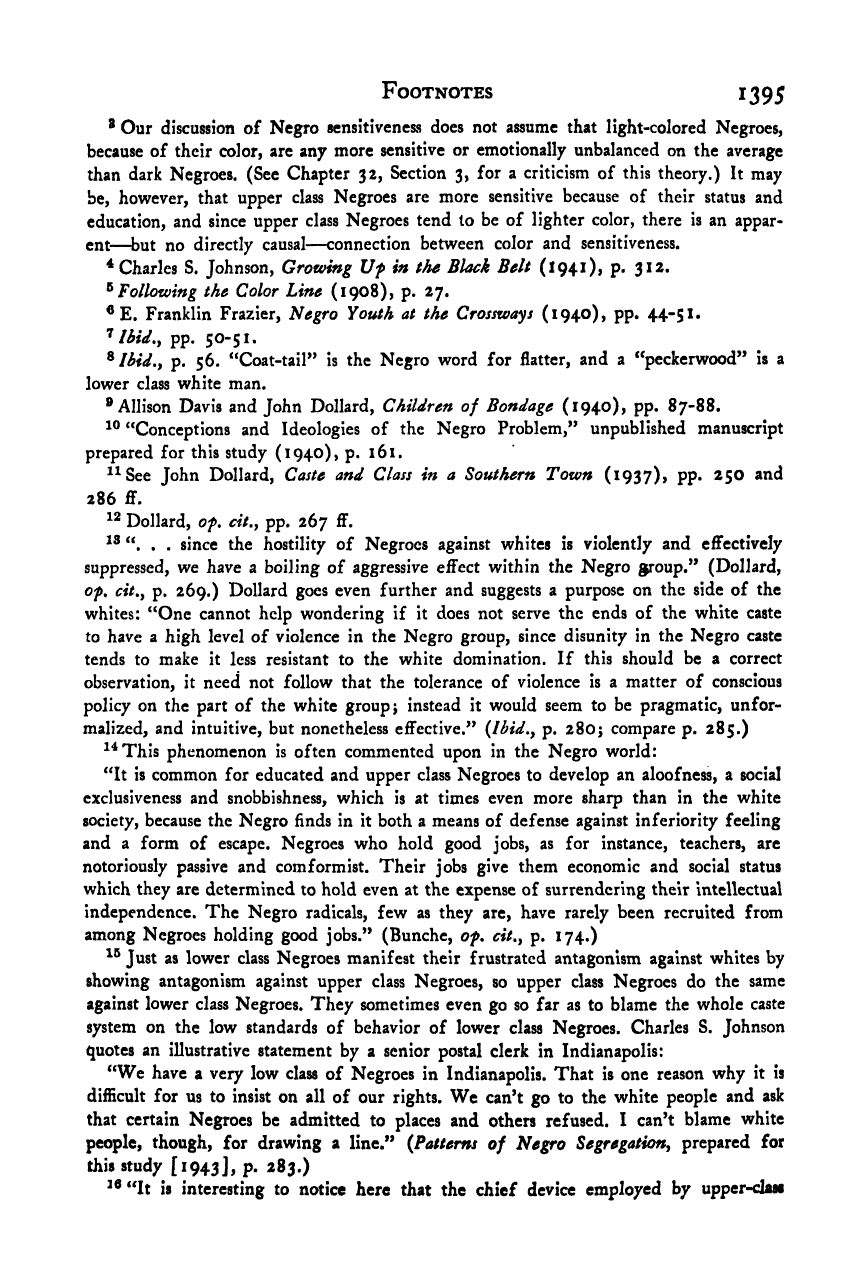Note: Gunnar Myrdal died in 1987, less than 70 years ago. Therefore, this work is protected by copyright, restricting your legal rights to reproduce it. However, you are welcome to view it on screen, as you do now. Read more about copyright.
Full resolution (TIFF) - On this page / på denna sida - Footnotes - Chapter 36

<< prev. page << föreg. sida << >> nästa sida >> next page >>
Below is the raw OCR text
from the above scanned image.
Do you see an error? Proofread the page now!
Här nedan syns maskintolkade texten från faksimilbilden ovan.
Ser du något fel? Korrekturläs sidan nu!
This page has never been proofread. / Denna sida har aldrig korrekturlästs.
Footnotes 1395
® Our discussion of Negro sensitiveness does not assume that light-colored Negroes,
because of their color, are any more sensitive or emotionally unbalanced on the average
than dark Negroes. (See Chapter 32, Section 3, for a criticism of this theory.) It may
be, however, that upper class Negroes are more sensitive because of their status and
education, and since upper class Negroes tend lo be of lighter color, there is an appar-
ent—^but no directly causal—connection between color and sensitiveness.
^Charles S. Johnson, Growing Uf in the Black Belt (1941), p. 312.
^Following the Color Line (1908), p. 27,
® E. Franklin Frazier, Negro Youth at the Crossways (1940), pp. 44~Sl*
Ibid.^ pp. 50-51.
^ Ibid.y p. 56. ‘‘Coat-tail” is the Negro word for flatter, and a “peckerwood” is a
lower class white man.
® Allison Davis and John Dollard, Children of Bondage (1940), pp. 87-88.
“Conceptions and Ideologies of the Negro Problem,” unpublished manuscript
prepared for this study (1940), p. l6x.
^^See John Dollard, Caste and Class in a Southern Town (1937), pp. 250 and
286 flF.
Dollard, of. cit.y pp. 267 ff.
“. . . since the hostility of Negroes against whites is violently and effectively
suppressed, we have a boiling of aggressive effect within the Negro group.” (Dollard,
Of. cit.y p. 269.) Dollard goes even further and suggests a purpose on the side of the
whites: “One cannot help wondering if it does not serve the ends of the white caste
to have a high level of violence in the Negro group, since disunity in the Negro caste
tends to make it less resistant to the white domination. If this should be a correct
observation, it need not follow that the tolerance of violence is a matter of conscious
policy on the part of the white group j instead it would seem to be pragmatic, unfor-
malized, and intuitive, but nonetheless effective.” {Ibid.y p. 2805 compare p. 285.)
^^This phenomenon is often commented upon in the Negro world:
“It is common for educated and upper class Negroes to develop an aloofness, a social
exclusiveness and snobbishness, which is at times even more sharp than in the white
society, because the Negro finds in it both a means of defense against inferiority feeling
and a form of escape. Negroes who hold good jobs, as for instance, teachers, are
notoriously passive and comformist. Their jobs give them economic and social status
which they are determined to hold even at the expense of surrendering their intellectual
independence. The Negro radicals, few as they are, have rarely been recruited from
among Negroes holding good jobs.” (Bunche, of. cit.y p. 174.)
Just as lower class Negroes manifest their frustrated antagonism against whites by
showing antagonism against upper class Negroes, so upper class Negroes do the same
against lower class Negroes. They sometimes even go so far as to blame the whole caste
system on the low standards of behavior of lower class Negroes. Charles S. Johnson
quotes an illustrative statement by a senior postal clerk in Indianapolis:
“We have a very low class of Negroes in Indianapolis. That is one reason why it is
difficult for us to insist on all of our rights. We can’t go to the white people and ask
that certain Negroes be admitted to places and others refused. I can’t blame white
people, though, for drawing a line.” {Patterns of Negro Segregationy prepared for
this study [1943J, p. 283.)
“It is interesting to notice here that the chief device employed by upper-clasi
<< prev. page << föreg. sida << >> nästa sida >> next page >>